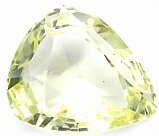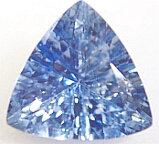|
|
What are Jyotish Quality Gemstones? Beliefs &
Facts 2 | planetarygems.com
In the previous page, we have seen which clarity to look for
in an effective Jyotish quality gemstone. We have also clarified a bit about color as well.
In this contest, we would like to spend a few words
about Cutting.
Cutting, as per our opinion, is another very important characteristic in a Jyotish
quality gem and I would not hesitate to list it a primary factor for effectiveness
.
As a rule of thumb, a well cut gem has more life, vibration, character
and beauty of a poorly cut gem.
A well-cut faceted
gemstone reflects the light back evenly across its surface area when held face up. If the stone is too deep and narrow, areas
will be dark. If it is too shallow and wide, parts of the stone will be washed
out and lifeless (the so-called window...see the stone below, on the
left). The best way to judge cut is to look at similar gemstones next to
each other.
Like in everything else, there is an exception to the rule, and that is
when we are in the presence of a gem quality gemstone (again, gem quality is the
combination of excellent clarity, top color and relatively decent size). In this
case, if the big size, top clarity and perfect color are all there, the cut can
be not as perfect as it should be (and in many, real cases, some imperfections
in the cutting are the norm.)
To summarize, a good
cutting in a gem, can be compared to a good house, well built, perfect and accurate in all its details.
It is a pleasure to live in a nice house!. On the other hand, if the house is
not well built, and many comforts are missing, we do not enjoy it.
See the samples below for a visual understanding.
|
 |

|
 |
|
A very poorly cut, green sapphire.
Note the disturbing "window" in the middle of the gem. No sparkle is
produced by this cutting. |
A good, acceptable cutting, with
moderate window. However, being a rare Thai ruby, the window
is well forgiven by the exceptional, flawless clarity of this gem. |
Perfect cutting, with no window.
The light is reflected perfectly throughout the stone. Super lustrous gem, with
vibrant presence and character. |
Now let's talk about
Treatments:
Because, we aspire perfection...
Gemstones have been treated since the beginning of their
trade. The Roman historian Pliny mention in its "Historia Naturalis", how to
"transform one stone into another". Even Egyptians had written detailed methods
of treating gems. Of course, the purpose of treatments is to improve a stone's
appearance.
In Vedic gemology, a natural gem to be used in a good fortune, lucky talisman, is preferred to be untreated. First question is: Are untreated gems readily available in today's market place?
Nowadays,
gem treatments are done
routinely and are an intrinsic part of the trade. It is estimated that a good
90% of all gem material mined is treated some way or another. Natural gem
varieties are subjected to heat treatment, irradiation, color diffusion, coating
dyeing, oiling, polymers intrusion to name the most common...and for sure I am
leaving few others out.
In regards of the nine, astrological Jyotish gemstones, the possible treatments we will face are heat treatment for rubies, all color
sapphires, green and red tourmalines, topazes. Dyeing and coating for pearls and
red corals, oiling or polymers for emeralds, irradiation for diamonds. Hessonites, rhodolites, and all other
garnets along with cat's eye chrysoberyls, spinels, damburites, kyanites are
never treated.
For Jyotish purposes, let's examine
in more details the
possible treatments done
to the 9 gems used in Vedic astrology.
Sapphires:
...It is estimated that 96% of total, worldwide production of sapphires are heated to improve on color and clarity.
A small 4% is available unheated. Scientific knowledge of unheated crystal
characteristics is a must to differentiate in between heated and not heated
sapphires.
Sometimes, though, sapphires (white sapphires are the best example) are
heated at low temperatures (around 500
to 700 degrees Celtius), opposed to high temperature
treatment, which is just below the sapphire melting point. Low heat treatment is done to
remove excessive rutile (the so called "silk") from the stone inside. This low
heat treatment is sometimes very difficult to detect as the crystal DOES NOT undergo major
changes. As major gem labs, or even very experted gemologists and dealers cannot
detect low heat treatment, is then the stone truly unheated or it is considered
heat treated?
The only person that knows exactly how much a stone has been heated or not at
all is the miner. Example, miners in Sri Lanka are experts in determining the
quality and characteristics of a rough specimen usually, after being brought up
from the mine's depth, and washed. Only the miner will know if a stone has
to be heated or not, but then again, is low heat treatment considered bad for the
astrological effect or not...Understandably, we have a dilemma here. .........
Use your
instinct. do not analyze with your mind, do not get
fooled by the seller that tries to convince you...follow your
heart, feel the honesty and intentions. Ultimately, let the stone talk to you,
not the person.
|